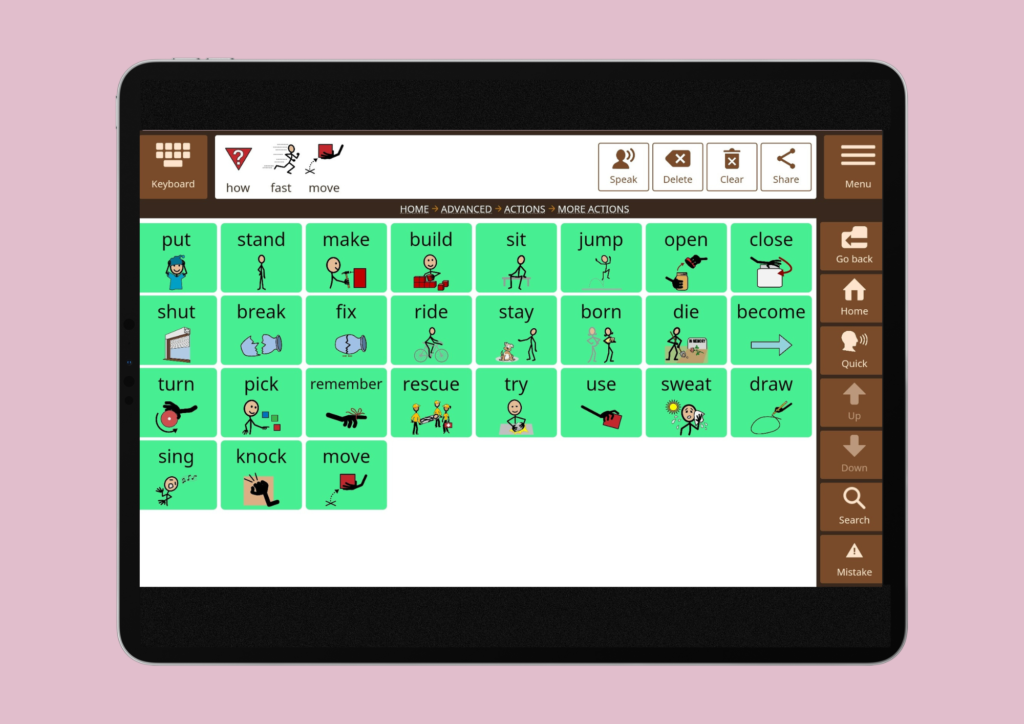Descriptive teaching creates a conducive environment for AAC users to learn more effectively. In this blog, Avaz’s resident SLP Nayantara gives you some subject wise tips to implement some of these methods in your classroom.
Descriptive Teaching = Better Learning
Are you a teacher looking for ways to support students who use AAC devices in the classroom? Are you struggling to find the right words to model for them, or wondering how to help them understand academic concepts? Look no further! Descriptive teaching is the solution you have been looking for. By using core words and rephrasing questions, you can create a learning environment that meets the needs of your AAC students and enables them to better participate in class. Let us dive into some examples and see how this approach can transform your students’ learning experience.
Classroom Considerations for Descriptive Teaching
When working within the classroom context, these are some of the questions teachers might be considering
- What words to model for the AAC user?
- How to teach them academic concepts?
- What are the expectations for responses from them?
There is one solution to all of these concerns and that is to use the principles of descriptive teaching to plan your lessons ahead of time. As you know, descriptive teaching involves using core words to help AAC users understand concepts better using the vocabulary that already exists within their AAC system. In addition to this, this teaching model also recommends that when we test those users about the topic, we rephrase our questions such that we can accommodate answers that again would be present within the AAC system already.
Let’s look at some examples to understand this further.


Math
So imagine that the topic on hand is ‘speed’. An ideal definition of ‘speed’ is distance divided by time. But if we had to reframe our definition we could teach it as:
HOW FAST an object MOVEs.
So having modelled the words HOW FAST MOVE, we are able to convey the same message as the ideal definition but also do it in a way that it can be understood easily and with simple core words.
When the time comes to test this concept, the common question asked by teachers would be, “How can you measure speed?” and the expected response would be the formula for speed.
Instead, we could ask a question like “How can you describe speed?” and by this we are enabling the AAC user to define it in their own way, using the words they are familiar with.
| Old question | (Accommodative) New question |
| What is the measurement of speed? | How would you describe speed? |
Science
Now let’s come to science class and this time we are learning about ‘comets’.
This is NASA’S definition of a comet: “Comets are frozen leftovers from the formation of the solar system composed of dust, rock, and ices. They range from a few miles to tens of miles wide, but as they orbit closer to the Sun, they heat up and spew gases and dust into a glowing head that can be larger than a planet. This material forms a tail that stretches millions of miles.”
The teacher can transform the above definition and teach it like this:
- Comets are COLD ICY FROZEN SMALL objects found in the solar system.
- When they get NEAR the sun they get HOT and GIVE OUT gases and dust. At this stage they are BIG.
- This gas and dust forms a LONG tail which stretches very FAR.
So during the quiz at the end of the class, we can also transform the question asked, in this way:
| Old question | New question |
| What is a comet? | Describe how a comet is formed? |
English


In an English lesson let’s say the teacher was teaching spelling rules for the day.
The rule is “ i before e except after c”.
The rule already comes with its own set of core words BUT we can add one more and make it a sentence rich with core words.
The teacher can teach the rule as:
“I BEFORE e, BUT NOT AFTER c”
We learn a spelling rule but also 4 different core words in this way.
Looking through a writing assignment, the teacher could remind the AAC user about this spelling rule by asking:
| Old question | New question |
| This spelling is incorrect, can you tell me why? | “ i before e but………..?” |
We need not even ask a question! We can start saying the first few words of the rule and pause and let the AAC user complete the rest.
Social Science
Now getting to some social studies topics, an important topic is learning about democracy. A democracy can be defined in many ways.
Longer definition
“Democracy is a form of government in which the people have the authority to deliberate and decide legislation, or to choose governing officials to do so”
This can be taught using a variety of action words that have similar meaning. We could teach:
Democracy is when people can CHOOSE or PICK or DECIDE or even SELECT their leaders.
Shorter definition
We could also teach them a shorter version using Abraham Lincoln’s statement about democracy and freedom:
OF the people, BY the people, FOR the people, which as you can see is perfect for teaching core words on its own.
So the question allowing for this descriptive definition would be:
| Old question | New question |
| Define Democracy | What have you understood about being in a democracy? |
Physical Education (PE)
A physical education class would have a treasure trove of words to model and describe as there are many actions performed in these classes. It starts with the names of the exercises:
STRECHes, JUMPING jacks, CLIMB the rope, MARCH, THROWball, etc.


In addition to this, we can use more core words to describe the instructions for these exercises:
BEND your hips MORE.
JUMP HIGHER.
HOLD onto the rope.
MARCH slower, MOVE your legs at the same time.
I need a STRONG THROW this time, it needs to go FAR.
When AAC users are back to class and sharing their experience of PE, the teacher can ask:
| Old question | New question |
| List the names of the exercises completed in PE class. | What actions did you try in PE class today? |
Conclusion
Every lesson in a school context can be transformed in a way to teach core words and be inclusive of different modes of communication including using an AAC system. This ensures greater participation from the AAC user which in turn, boosts their confidence with learning.
An SLP can work with the teachers and as a team they can reevaluate how to use descriptive teaching within the classroom topics and how to test these topics to best accommodate for the altered instruction.
WRITTEN BY
Nayantara Nambiar, MSP, BASLP
Speech Language Pathologist
Trained in India and Australia, I am passionate about supporting people with communication and swallowing difficulties. Equipped with experience in Rehabilitation, School and Early Intervention settings, I strive to provide a holistic intervention approach tailor-made for my clients and their families.





